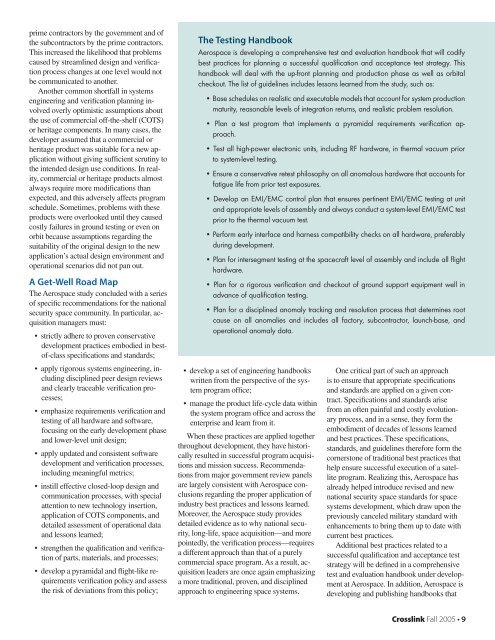A Successful Strategy for Satellite Development and Testing - Inpe
A Successful Strategy for Satellite Development and Testing - Inpe
A Successful Strategy for Satellite Development and Testing - Inpe
- No tags were found...
Create successful ePaper yourself
Turn your PDF publications into a flip-book with our unique Google optimized e-Paper software.
prime contractors by the government <strong>and</strong> ofthe subcontractors by the prime contractors.This increased the likelihood that problemscaused by streamlined design <strong>and</strong> verificationprocess changes at one level would notbe communicated to another.Another common shortfall in systemsengineering <strong>and</strong> verification planning involvedoverly optimistic assumptions aboutthe use of commercial off-the-shelf (COTS)or heritage components. In many cases, thedeveloper assumed that a commercial orheritage product was suitable <strong>for</strong> a new applicationwithout giving sufficient scrutiny tothe intended design use conditions. In reality,commercial or heritage products almostalways require more modifications thanexpected, <strong>and</strong> this adversely affects programschedule. Sometimes, problems with theseproducts were overlooked until they causedcostly failures in ground testing or even onorbit because assumptions regarding thesuitability of the original design to the newapplication’s actual design environment <strong>and</strong>operational scenarios did not pan out.A Get-Well Road MapThe Aerospace study concluded with a seriesof specific recommendations <strong>for</strong> the nationalsecurity space community. In particular, acquisitionmanagers must:• strictly adhere to proven conservativedevelopment practices embodied in bestof-classspecifications <strong>and</strong> st<strong>and</strong>ards;• apply rigorous systems engineering, includingdisciplined peer design reviews<strong>and</strong> clearly traceable verification processes;• emphasize requirements verification <strong>and</strong>testing of all hardware <strong>and</strong> software,focusing on the early development phase<strong>and</strong> lower-level unit design;• apply updated <strong>and</strong> consistent softwaredevelopment <strong>and</strong> verification processes,including meaningful metrics;• instill effective closed-loop design <strong>and</strong>communication processes, with specialattention to new technology insertion,application of COTS components, <strong>and</strong>detailed assessment of operational data<strong>and</strong> lessons learned;• strengthen the qualification <strong>and</strong> verificationof parts, materials, <strong>and</strong> processes;• develop a pyramidal <strong>and</strong> flight-like requirementsverification policy <strong>and</strong> assessthe risk of deviations from this policy;The <strong>Testing</strong> H<strong>and</strong>bookAerospace is developing a comprehensive test <strong>and</strong> evaluation h<strong>and</strong>book that will codifybest practices <strong>for</strong> planning a successful qualification <strong>and</strong> acceptance test strategy. Thish<strong>and</strong>book will deal with the up-front planning <strong>and</strong> production phase as well as orbitalcheckout. The list of guidelines includes lessons learned from the study, such as:• Base schedules on realistic <strong>and</strong> executable models that account <strong>for</strong> system productionmaturity, reasonable levels of integration returns, <strong>and</strong> realistic problem resolution.• Plan a test program that implements a pyramidal requirements verification approach.• Test all high-power electronic units, including RF hardware, in thermal vacuum priorto system-level testing.• Ensure a conservative retest philosophy on all anomalous hardware that accounts <strong>for</strong>fatigue life from prior test exposures.• Develop an EMI/EMC control plan that ensures pertinent EMI/EMC testing at unit<strong>and</strong> appropriate levels of assembly <strong>and</strong> always conduct a system-level EMI/EMC testprior to the thermal vacuum test.• Per<strong>for</strong>m early interface <strong>and</strong> harness compatibility checks on all hardware, preferablyduring development.• Plan <strong>for</strong> intersegment testing at the spacecraft level of assembly <strong>and</strong> include all flighthardware.• Plan <strong>for</strong> a rigorous verification <strong>and</strong> checkout of ground support equipment well inadvance of qualification testing.• Plan <strong>for</strong> a disciplined anomaly tracking <strong>and</strong> resolution process that determines rootcause on all anomalies <strong>and</strong> includes all factory, subcontractor, launch-base, <strong>and</strong>operational anomaly data.• develop a set of engineering h<strong>and</strong>bookswritten from the perspective of the systemprogram office;• manage the product life-cycle data withinthe system program office <strong>and</strong> across theenterprise <strong>and</strong> learn from it.When these practices are applied togetherthroughout development, they have historicallyresulted in successful program acquisitions<strong>and</strong> mission success. Recommendationsfrom major government review panelsare largely consistent with Aerospace conclusionsregarding the proper application ofindustry best practices <strong>and</strong> lessons learned.Moreover, the Aerospace study providesdetailed evidence as to why national security,long-life, space acquisition—<strong>and</strong> morepointedly, the verification process—requiresa different approach than that of a purelycommercial space program. As a result, acquisitionleaders are once again emphasizinga more traditional, proven, <strong>and</strong> disciplinedapproach to engineering space systems.One critical part of such an approachis to ensure that appropriate specifications<strong>and</strong> st<strong>and</strong>ards are applied on a given contract.Specifications <strong>and</strong> st<strong>and</strong>ards arisefrom an often painful <strong>and</strong> costly evolutionaryprocess, <strong>and</strong> in a sense, they <strong>for</strong>m theembodiment of decades of lessons learned<strong>and</strong> best practices. These specifications,st<strong>and</strong>ards, <strong>and</strong> guidelines there<strong>for</strong>e <strong>for</strong>m thecornerstone of traditional best practices thathelp ensure successful execution of a satelliteprogram. Realizing this, Aerospace hasalready helped introduce revised <strong>and</strong> newnational security space st<strong>and</strong>ards <strong>for</strong> spacesystems development, which draw upon thepreviously canceled military st<strong>and</strong>ard withenhancements to bring them up to date withcurrent best practices.Additional best practices related to asuccessful qualification <strong>and</strong> acceptance teststrategy will be defined in a comprehensivetest <strong>and</strong> evaluation h<strong>and</strong>book under developmentat Aerospace. In addition, Aerospace isdeveloping <strong>and</strong> publishing h<strong>and</strong>books thatCrosslink Fall 2005 • 9
















